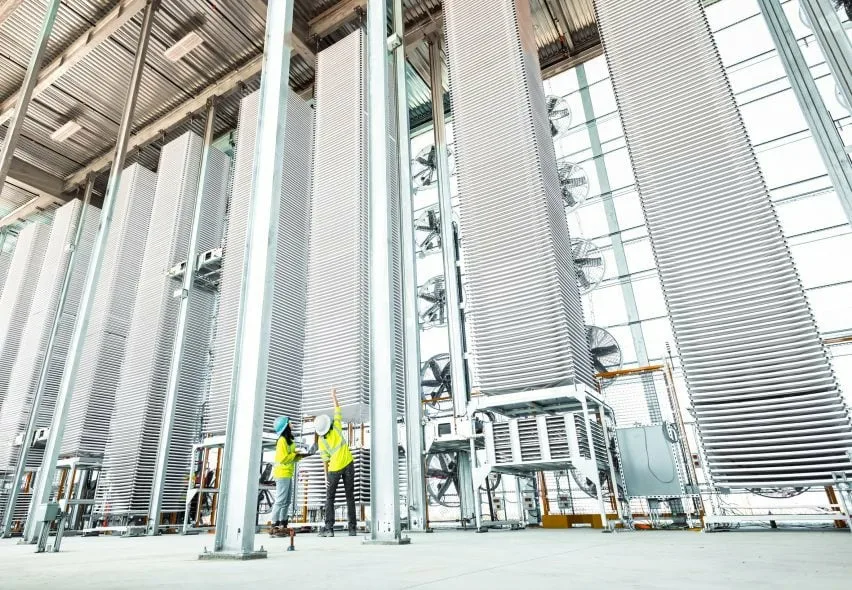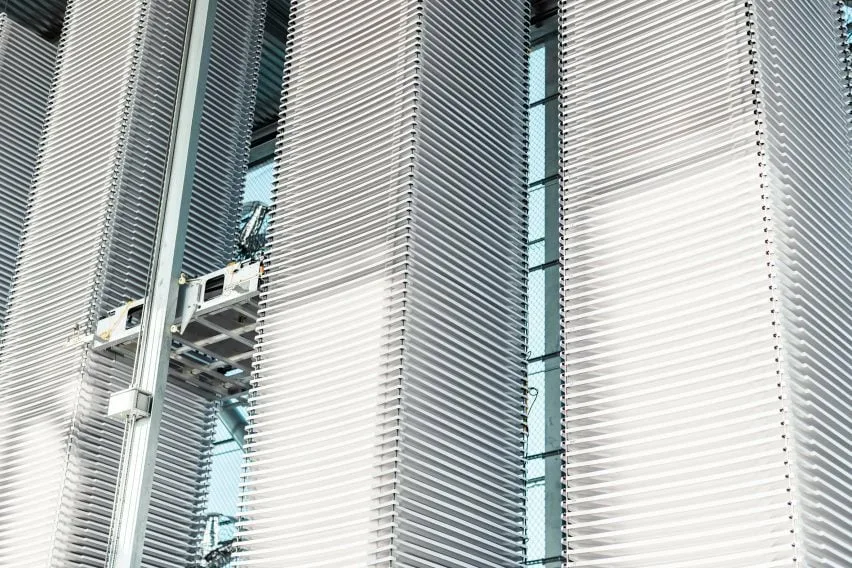The demand for Direct Air Capture (DAC) technology has gained traction as societies worldwide seek innovative solutions to combat climate change. With an increasing awareness of the urgent need to reduce atmospheric carbon dioxide levels, it has garnered interest from governments and industries around the globe. The appeal of DAC lies in its potential to actively remove carbon emissions from the air, offering a supplementary strategy alongside traditional mitigation efforts. As carbon reduction targets become more ambitious, the demand for scalable and cost-effective DAC technology will continue to grow, driven by the imperative to achieve net-zero emissions and address the escalating impacts of climate change. Several initiatives are being taken across the world to streamline the technology.
In regard to this growing demand,In the Californian town of Tracy, within a sprawling new warehouse, one finds tall towers of trays containing grey powder neatly stacked in rows. This warehouse is part of Heirloom, a company committed to using limestone to directly extract carbon dioxide from the air, subsequently storing it deep within concrete to prevent its release into the atmosphere. The recently opened facility represents the first commercial direct air capture (DAC) plant in the United States.
The concept of capturing and storing carbon from the air was once viewed as far-fetched, but today, it’s seen as an essential tool in addressing the climate crisis. Substantial funding, both from private and public sources, is flowing into this field, with the Biden administration allocating at least $3.7 billion to initiate DAC and other carbon-removal projects across the country.
Heirloom’s Innovative Process
Heirloom’s unique approach involves harnessing the power of limestone, the second most-mined material globally, for direct air capture. Through a meticulous process, industrial kilns heat limestone to extreme temperatures, breaking it down into carbon dioxide and calcium oxide. The captured carbon dioxide finds a home in concrete for construction purposes, while the remaining calcium oxide powder is strategically spread on trays. Exposed to open air and water, this powder naturally absorbs carbon, setting off a sustainable cycle that utilizes heat to separate and capture the reclaimed carbon.Unlike other DAC systems that rely on large fans to pull air, Heirloom incorporates a few fans, asserting that its system consumes less energy by leveraging limestone’s natural ability to attract carbon molecules.

How does the carbon capture process work?
I. Raw Material: Limestone as a Catalyst
Heirloom’s carbon capture process begins with the utilization of limestone, the second most-mined material on Earth. This abundant and naturally occurring resource plays a pivotal role as a catalyst in transforming atmospheric carbon dioxide into a more stable form.

II. Thermal Treatment in Industrial Kilns
The limestone undergoes a transformative process in industrial kilns where it is subjected to intense heat. The temperature reaches a formidable 1,650°F (899°C), a critical phase that initiates the breakdown of limestone into two primary components: carbon dioxide and calcium oxide.

III. Carbon Dioxide Storage in Concrete
The separated carbon dioxide is then directed towards concrete, where it is strategically stored. This serves a dual purpose: creating a valuable construction material and concurrently sequestering carbon. By storing carbon in this way, Heirloom ensures a long-term and stable repository, preventing its release back into the atmosphere.

IV. Formation of Calcium Oxide Powder
Post-extraction of carbon dioxide, what remains is calcium oxide powder. This byproduct holds significant potential for carbon capture and becomes a key element in the cyclical nature of Heirloom’s carbon capture system.

V. Tray Arrangement and Exposure to Open Air
The calcium oxide powder is spread across trays in an organized fashion, exposed to the open air. This is a crucial step in the process, setting the stage for the powder’s interaction with its surroundings.

VI. Water Activation
An important moment occurs as water is introduced into the equation. The sprayed trays undergo interaction with water, activating the natural carbon-absorbing properties of the calcium oxide powder.

VII. Natural Carbon Absorption Mechanism
As the trays, laden with calcium oxide powder, are exposed to the open air, the powder initiates a natural process of absorbing carbon. This involves the powder binding with carbon molecules in the atmosphere, effectively drawing carbon out and beginning the cycle of carbon capture.

VIII. Heat-Driven Separation and Renewal
To complete the cycle, heat is reintroduced into the system. This heat-driven step serves to separate the newly captured carbon from the calcium oxide. The separated carbon is stored within concrete, ready to be utilized for construction projects, while the calcium oxide powder, now devoid of carbon, is spread on trays once again. This marks the initiation of a renewed cycle of carbon capture.
Heirloom takes pride in the energy efficiency of its process, attributing it to the innate ability of limestone to attract carbon molecules. Unlike other direct air capture systems relying heavily on large fans to pull air, the system leverages the natural tendencies of limestone, enhancing the sustainability of the overall process.

The Vision of Heirloom
Shashank Samala, Heirloom’s CEO, driven by childhood experiences in south-east India amid heatwaves and droughts, envisions the warehouse as the first of many. Despite the facility’s current capacity of absorbing a maximum of 1,000 metric tons of CO2 per year, a fraction of a gas-fired power plant’s annual emissions, the company aims to remove 1 billion tons of carbon dioxide by 2035. However, Samala acknowledges the challenge of scaling up, requiring a threefold increase in capacity each year to meet their goals.
Heirloom says it’s powered by renewable energy from a local provider, and that it won’t take investments from oil and gas companies. One use for carbon captured from DAC plants is to enhance oil extraction by injecting carbon into oil wells to make them more productive, but that doesn’t align with the company’s values. “We felt the space needed leadership and values and we wanted to make sure that the carbon dioxide pulled from the air is not used as an excuse to put more CO2 into the air,” said Samala.
Funding and Tech Company Partnerships
Recognizing the need for substantial investment, Heirloom has secured crucial partnerships with tech industry giants. Microsoft, in a long-term contract, commits to offsetting a significant portion of its emissions through Heirloom’s carbon capture. Similarly, the Frontier fund pledges substantial financial support not only to Heirloom but also to other ventures dedicated to carbon capture.
Commitment to Values
Heirloom distinguishes itself by emphasizing its commitment to renewable energy sourced from local providers and a firm stance against investments from oil and gas companies. This commitment extends to ensuring that the captured carbon doesn’t serve as a means to justify reintroducing CO2 into the atmosphere, aligning the company’s actions with its core values.

Hurdles and Expert Perspectives
Acknowledging the formidable challenges of direct air capture, experts such as Farzan Kazemifar and Brad Sageman shed light on the economic and energy-intensive nature of the process. The vastness of the atmosphere and the necessity for powerful fans pose significant hurdles. Despite these challenges, there is unanimous agreement among experts on the imperative to explore diverse solutions to the climate crisis.
Future Prospects and Social Responsibility
Shashank Samala expresses hope for increased global awareness regarding the role of direct air capture. He advocates for a paradigm shift in societal mindset, drawing an analogy to city governments paying for waste removal. In his view, individuals and entities should consider paying for the removal of the carbon they contribute to the environment, fostering a sense of social and environmental responsibility.
What is Direct Air Capture (DAC) technology?
Direct Air Capture (DAC) is a technology designed to actively remove carbon dioxide (CO2) from the ambient air. The process typically involves large-scale machines equipped with chemical sorbents or filters that selectively capture CO2 when air passes through them. Once captured, the CO2 can be stored underground, utilized in various industrial processes, or potentially converted into products.
Key components of DAC systems include:
1. Adsorption or Absorption: Most DAC systems use materials that either adsorb or absorb CO2 from the air. These materials can then release the captured CO2 under specific conditions, allowing for its storage or utilization.
2. Separation: After capturing CO2, the DAC system needs to separate it from the sorbent material. This step is crucial for the efficient storage or utilization of the captured carbon.
3. Storage or Utilization: Captured CO2 can be stored underground in geological formations or used in various industrial processes, such as carbonating beverages or producing synthetic fuels and materials.
4. Energy Input: DAC systems require energy to operate, and the source of this energy plays a crucial role in determining the overall environmental impact. Using renewable energy sources can enhance the sustainability of DAC.
Conclusion
Heirloom’s venture into direct air capture not only marks a significant milestone in environmental innovation but also underscores the evolving landscape of climate solutions. As technology and funding converge, the Tracy facility exemplifies a pioneering step toward mitigating the impact of carbon emissions on the environment, urging a collective reevaluation of our responsibilities in the face of the climate crisis.
References- Carboncredits.com, theguardian.com, dezeen.com

